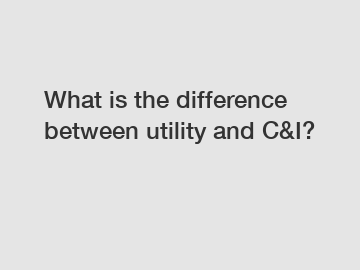What is the difference between utility and C&I?
Are you confused about the difference between utility and C&I? Don't worry, you're not alone. Many people are unsure about what these terms mean and how they are different. In this article, we will explain the key differences between utility and C&I in a simple and easy-to-understand way.
What is a Utility?
Let's start with utility. A utility is a company that provides essential services such as electricity, water, or gas to customers. Utilities are responsible for generating, transmitting, and distributing these services to homes, businesses, and other places.

Utilities are typically regulated by government agencies to ensure that they provide reliable and affordable services to their customers. They operate a network of infrastructure, such as power plants, transmission lines, and distribution systems, to deliver services to customers.
What is C&I?
On the other hand, C&I stands for Commercial and Industrial customers. These are businesses that consume large amounts of electricity or other utilities in their operations. C&I customers can include factories, offices, retail stores, hospitals, and other commercial establishments.
C&I customers have different energy needs than residential customers. They often require more reliable power supply, higher levels of service, and tailored solutions to meet their specific requirements. C&I customers may also have more complex billing structures and energy management strategies.
Differences Between Utility and C&I.
1. Customer Type.
One of the main differences between utility and C&I is the type of customer they serve. Utilities provide services to a wide range of customers, including residential, commercial, and industrial. C&I, on the other hand, specifically refers to commercial and industrial customers that have higher energy needs.
2. Energy Consumption.
Another difference is the amount of energy consumed by each type of customer. C&I customers typically consume larger amounts of energy compared to residential customers. This is because commercial and industrial operations often require more power to run their equipment and facilities.
3. Service Level.
Utilities provide a standardized level of service to all customers, regardless of their size or energy consumption. In contrast, C&I customers may require customized solutions, tailored energy management strategies, and higher levels of reliability and support from their utility provider.
4. Billing Structure.
The billing structure for utility and C&I customers can also differ. C&I customers may have more complex billing structures, including demand charges, time-of-use pricing, and other specialized rates that reflect their energy usage patterns and requirements.
In conclusion, the main difference between utility and C&I lies in the type of customer they serve, the amount of energy consumed, the level of service provided, and the billing structure. Understanding these key differences can help you better navigate the energy market and make informed decisions for your business.
If you have any questions about utility or C&I services, feel free to contact us. Our team of experts can help you find the right supplier and solutions for your energy needs.
Want more information on C&I Battery Storage, Lithium Phosphate Battery Pack DIY Kits, C&I Energy Storage System? Feel free to contact us.

Comments